Abstract
BACKGROUND: To assess the possible magnitude of differences between normal populations an epidemiological investigation of asthma was conducted in two strongly contrasting districts of northern England--rural West Cumbria on the west coast and urban Newcastle upon Tyne on the east coast. METHODS: A cross sectional survey of randomly identified men aged 20-44 years was conducted in two phases: phase 1, a postal survey of respiratory symptoms and asthma medication in 3000 men from each district; and phase 2, a clinical assessment of 300 men from each district comprising investigator administered questionnaires, skin prick tests, spirometry, and methacholine challenge tests. RESULTS: The phase 1 (but not phase 2) study showed a small excess of "ever wheezed" in Newcastle (44% versus 40%), but neither phase showed differences between the two districts for recent wheeze or for other symptoms characteristic of asthma. There were also no differences with regard to diagnosed asthma, current asthma medication, spirometric parameters, or airways responsiveness. The prevalence of quantifiable airways responsiveness (PD20 < or = 6400 micrograms) was 27.7% in West Cumbria and 28.2% in Newcastle. Regression analyses showed that PD20 was negatively associated with atopy and positively with forced expiratory volume in one second (FEV1); that an association between PD20 and current smoking could be explained by diminished FEV1; and that PD20 was not related to geographical site of residence. CONCLUSIONS: Neither airways responsiveness nor the other parameters of diagnostic relevance to asthma varied much between the two study populations, despite the apparent environmental differences. The most obvious of these were the levels of outdoor air pollution attributable to vehicle exhaust emissions, the ambient levels of which were 2-10 fold greater in Newcastle. Our findings consequently shed some doubt over the role of such pollution in perceived recent increases in asthma prevalence. It is possible, however, that an air pollution effect in Newcastle has been balanced by asthmagenic effects of other agents in West Cumbria.
Full text
PDF
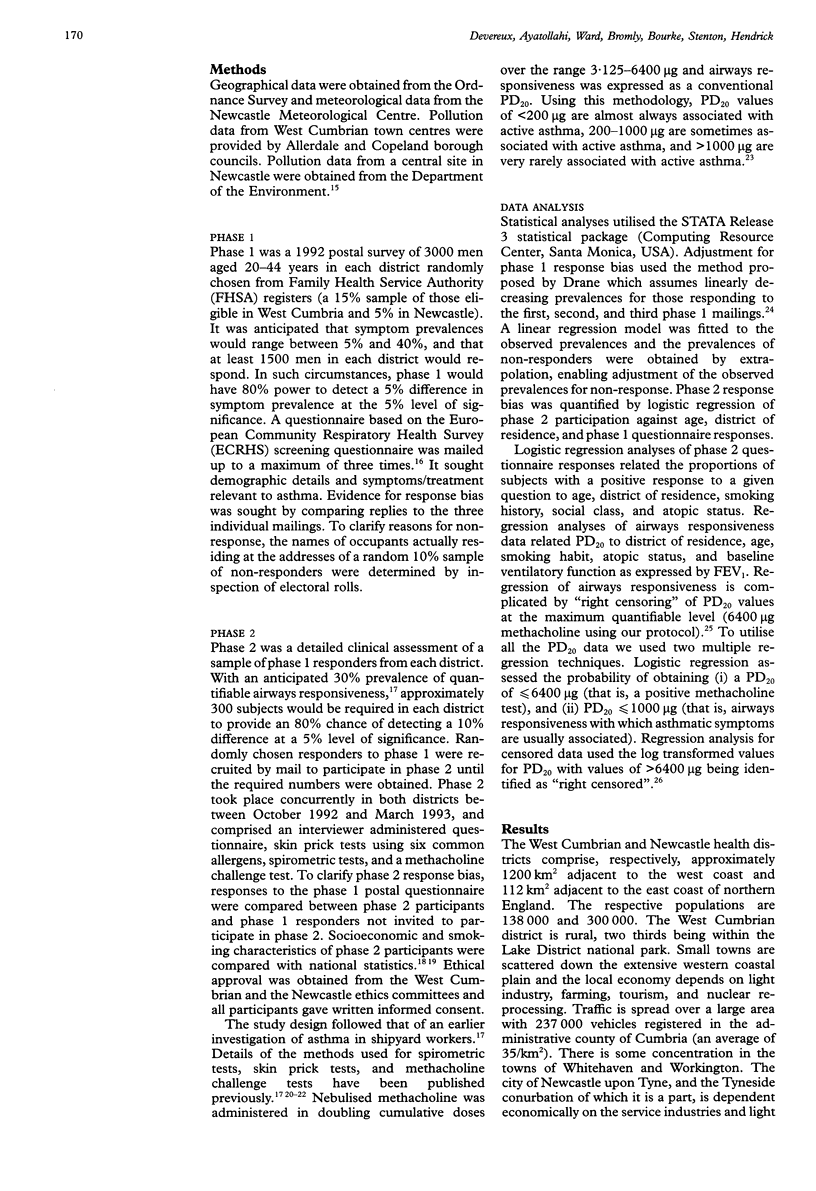
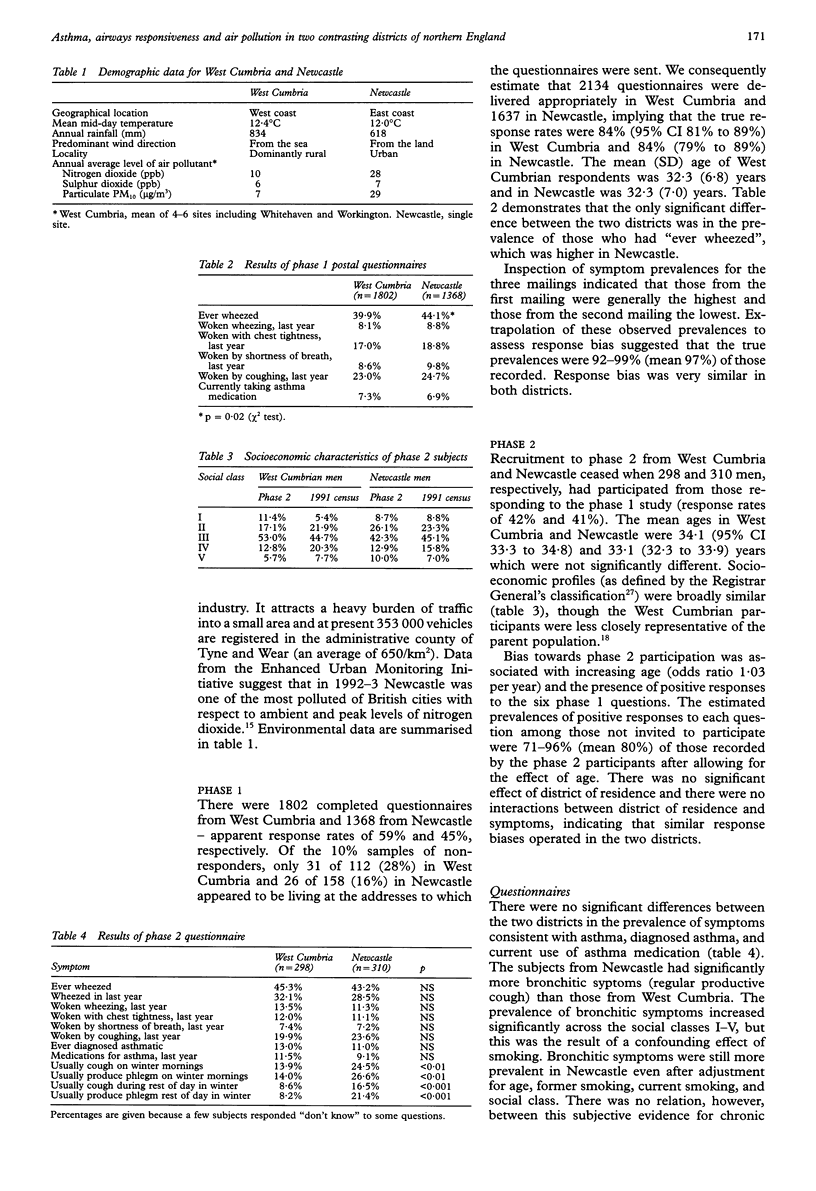
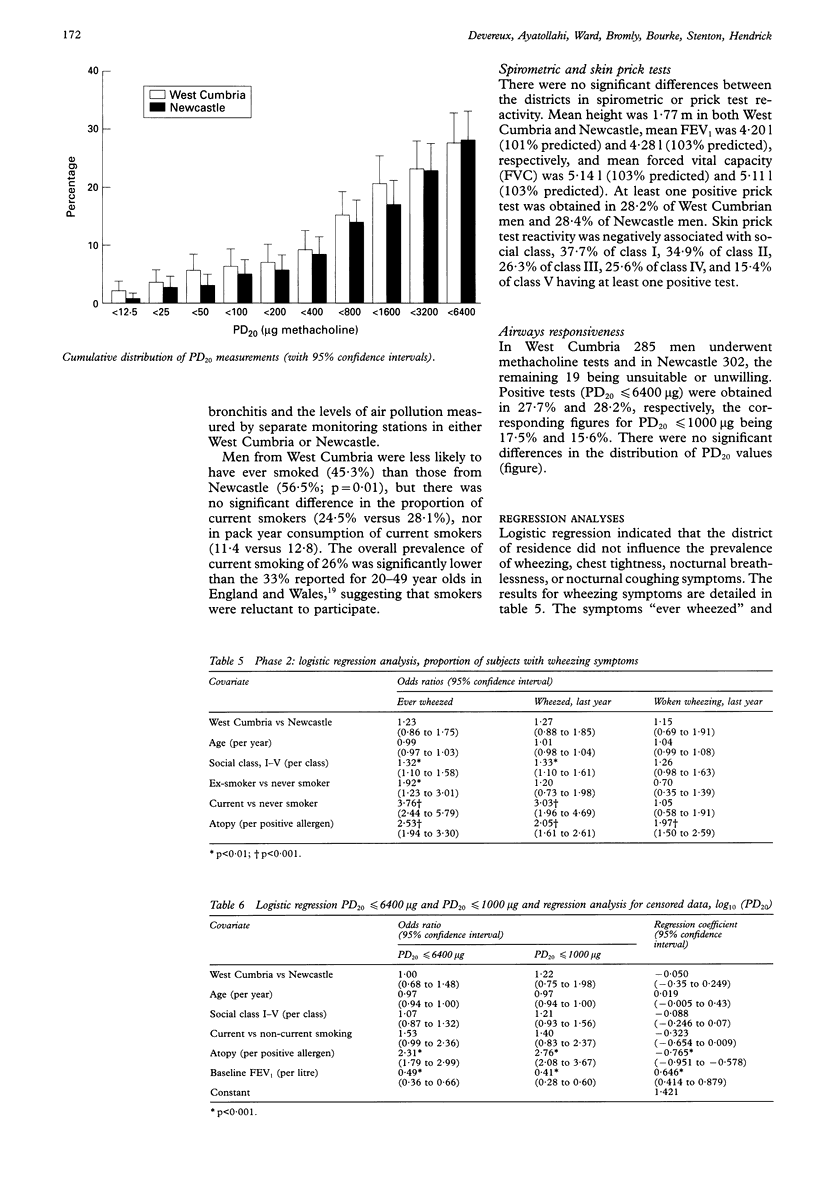
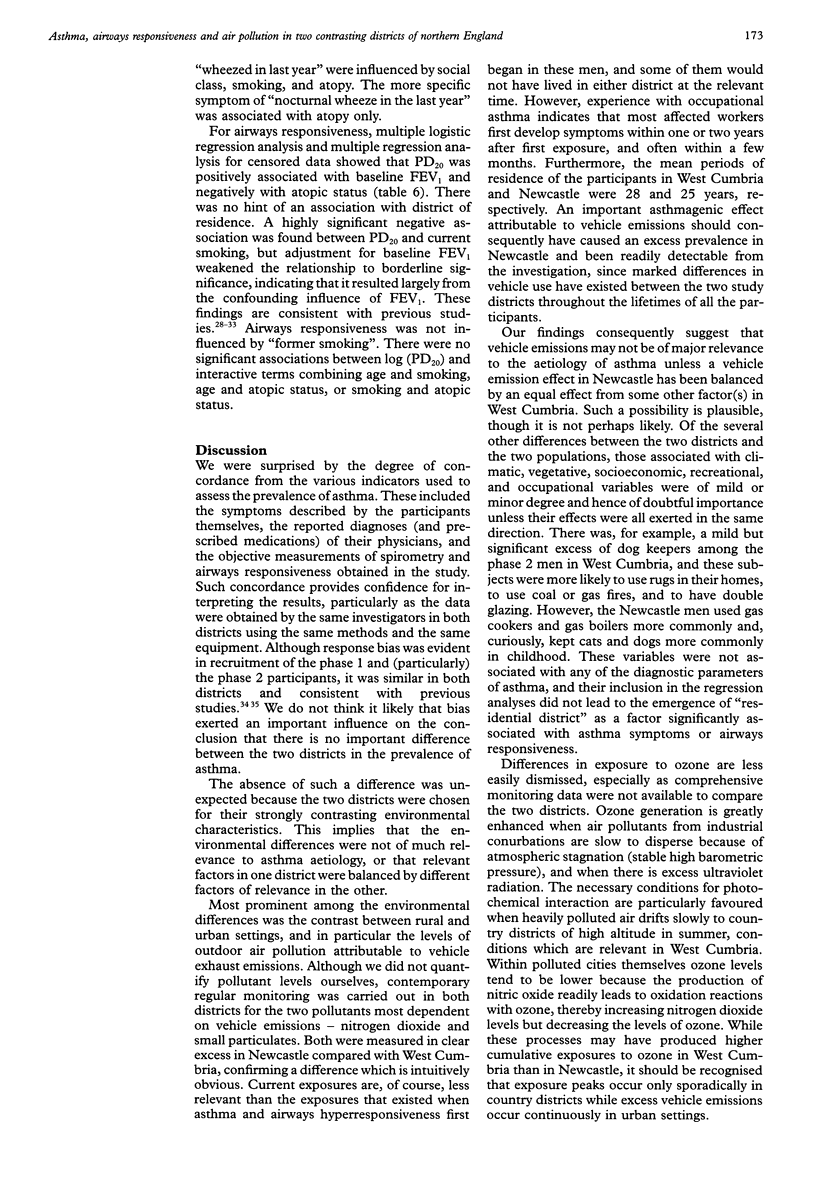
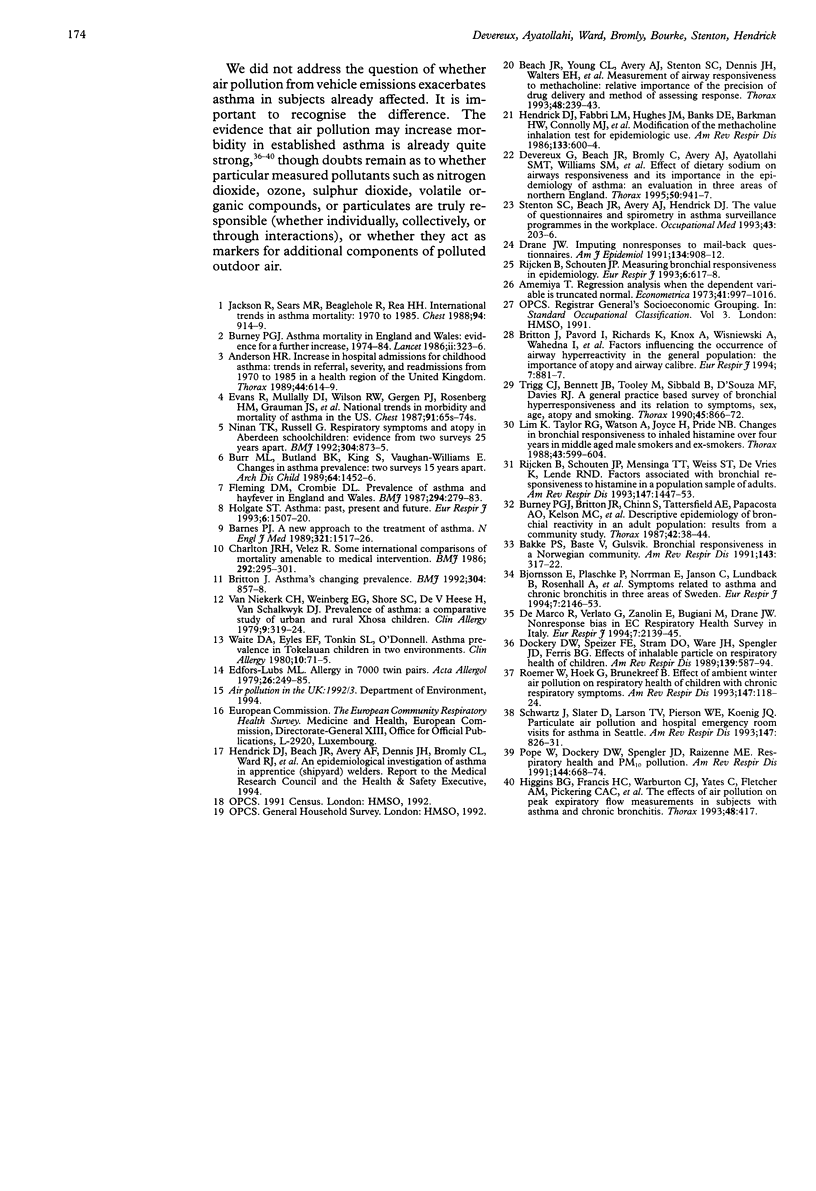
Selected References
These references are in PubMed. This may not be the complete list of references from this article.
- Anderson H. R. Increase in hospital admissions for childhood asthma: trends in referral, severity, and readmissions from 1970 to 1985 in a health region of the United Kingdom. Thorax. 1989 Aug;44(8):614–619. doi: 10.1136/thx.44.8.614. [DOI] [PMC free article] [PubMed] [Google Scholar]
- Bakke P. S., Baste V., Gulsvik A. Bronchial responsiveness in a Norwegian community. Am Rev Respir Dis. 1991 Feb;143(2):317–322. doi: 10.1164/ajrccm/143.2.317. [DOI] [PubMed] [Google Scholar]
- Barnes P. J. A new approach to the treatment of asthma. N Engl J Med. 1989 Nov 30;321(22):1517–1527. doi: 10.1056/NEJM198911303212206. [DOI] [PubMed] [Google Scholar]
- Beach J. R., Young C. L., Avery A. J., Stenton S. C., Dennis J. H., Walters E. H., Hendrick D. J. Measurement of airway responsiveness to methacholine: relative importance of the precision of drug delivery and the method of assessing response. Thorax. 1993 Mar;48(3):239–243. doi: 10.1136/thx.48.3.239. [DOI] [PMC free article] [PubMed] [Google Scholar]
- Björnsson E., Plaschke P., Norrman E., Janson C., Lundbäck B., Rosenhall A., Lindholm N., Rosenhall L., Berglund E., Boman G. Symptoms related to asthma and chronic bronchitis in three areas of Sweden. Eur Respir J. 1994 Dec;7(12):2146–2153. doi: 10.1183/09031936.94.07122146. [DOI] [PubMed] [Google Scholar]
- Britton J. Asthma's changing prevalence. BMJ. 1992 Apr 4;304(6831):857–858. doi: 10.1136/bmj.304.6831.857. [DOI] [PMC free article] [PubMed] [Google Scholar]
- Britton J., Pavord I., Richards K., Knox A., Wisniewski A., Wahedna I., Kinnear W., Tattersfield A., Weiss S. Factors influencing the occurrence of airway hyperreactivity in the general population: the importance of atopy and airway calibre. Eur Respir J. 1994 May;7(5):881–887. [PubMed] [Google Scholar]
- Burney P. G. Asthma mortality in England and Wales: evidence for a further increase, 1974-84. Lancet. 1986 Aug 9;2(8502):323–326. doi: 10.1016/s0140-6736(86)90012-7. [DOI] [PubMed] [Google Scholar]
- Burney P. G., Britton J. R., Chinn S., Tattersfield A. E., Papacosta A. O., Kelson M. C., Anderson F., Corfield D. R. Descriptive epidemiology of bronchial reactivity in an adult population: results from a community study. Thorax. 1987 Jan;42(1):38–44. doi: 10.1136/thx.42.1.38. [DOI] [PMC free article] [PubMed] [Google Scholar]
- Burr M. L., Butland B. K., King S., Vaughan-Williams E. Changes in asthma prevalence: two surveys 15 years apart. Arch Dis Child. 1989 Oct;64(10):1452–1456. doi: 10.1136/adc.64.10.1452. [DOI] [PMC free article] [PubMed] [Google Scholar]
- Charlton J. R., Velez R. Some international comparisons of mortality amenable to medical intervention. Br Med J (Clin Res Ed) 1986 Feb 1;292(6516):295–301. doi: 10.1136/bmj.292.6516.295. [DOI] [PMC free article] [PubMed] [Google Scholar]
- Devereux G., Beach J. R., Bromly C., Avery A. J., Ayatollahi S. M., Williams S. M., Stenton S. C., Bourke S. J., Hendrick D. J. Effect of dietary sodium on airways responsiveness and its importance in the epidemiology of asthma: an evaluation in three areas of northern England. Thorax. 1995 Sep;50(9):941–947. doi: 10.1136/thx.50.9.941. [DOI] [PMC free article] [PubMed] [Google Scholar]
- Dockery D. W., Speizer F. E., Stram D. O., Ware J. H., Spengler J. D., Ferris B. G., Jr Effects of inhalable particles on respiratory health of children. Am Rev Respir Dis. 1989 Mar;139(3):587–594. doi: 10.1164/ajrccm/139.3.587. [DOI] [PubMed] [Google Scholar]
- Drane J. W. Imputing nonresponses to mail-back questionnaires. Am J Epidemiol. 1991 Oct 15;134(8):908–912. doi: 10.1093/oxfordjournals.aje.a116165. [DOI] [PubMed] [Google Scholar]
- Edfors-Lubs M. L. Allergy in 7000 twin pairs. Acta Allergol. 1971 Aug;26(4):249–285. doi: 10.1111/j.1398-9995.1971.tb01300.x. [DOI] [PubMed] [Google Scholar]
- Fleming D. M., Crombie D. L. Prevalence of asthma and hay fever in England and Wales. Br Med J (Clin Res Ed) 1987 Jan 31;294(6567):279–283. doi: 10.1136/bmj.294.6567.279. [DOI] [PMC free article] [PubMed] [Google Scholar]
- Hendrick D. J., Fabbri L. M., Hughes J. M., Banks D. E., Barkman H. W., Jr, Connolly M. J., Jones R. N., Weill H. Modification of the methacholine inhalation test and its epidemiologic use in polyurethane workers. Am Rev Respir Dis. 1986 Apr;133(4):600–604. doi: 10.1164/arrd.1986.133.4.600. [DOI] [PubMed] [Google Scholar]
- Holgate S. T. The 1992 Cournand Lecture. Asthma: past, present and future. Eur Respir J. 1993 Nov;6(10):1507–1520. [PubMed] [Google Scholar]
- Jackson R., Sears M. R., Beaglehole R., Rea H. H. International trends in asthma mortality: 1970 to 1985. Chest. 1988 Nov;94(5):914–918. doi: 10.1378/chest.94.5.914. [DOI] [PubMed] [Google Scholar]
- Lim T. K., Taylor R. G., Watson A., Joyce H., Pride N. B. Changes in bronchial responsiveness to inhaled histamine over four years in middle aged male smokers and ex-smokers. Thorax. 1988 Aug;43(8):599–604. doi: 10.1136/thx.43.8.599. [DOI] [PMC free article] [PubMed] [Google Scholar]
- Ninan T. K., Russell G. Respiratory symptoms and atopy in Aberdeen schoolchildren: evidence from two surveys 25 years apart. BMJ. 1992 Apr 4;304(6831):873–875. doi: 10.1136/bmj.304.6831.873. [DOI] [PMC free article] [PubMed] [Google Scholar]
- Pope C. A., 3rd, Dockery D. W., Spengler J. D., Raizenne M. E. Respiratory health and PM10 pollution. A daily time series analysis. Am Rev Respir Dis. 1991 Sep;144(3 Pt 1):668–674. doi: 10.1164/ajrccm/144.3_Pt_1.668. [DOI] [PubMed] [Google Scholar]
- Rijcken B., Schouten J. P. Measuring bronchial responsiveness in epidemiology. Eur Respir J. 1993 May;6(5):617–618. [PubMed] [Google Scholar]
- Rijcken B., Schouten J. P., Mensinga T. T., Weiss S. T., De Vries K., Van der Lende R. Factors associated with bronchial responsiveness to histamine in a population sample of adults. Am Rev Respir Dis. 1993 Jun;147(6 Pt 1):1447–1453. doi: 10.1164/ajrccm/147.6_Pt_1.1447. [DOI] [PubMed] [Google Scholar]
- Roemer W., Hoek G., Brunekreef B. Effect of ambient winter air pollution on respiratory health of children with chronic respiratory symptoms. Am Rev Respir Dis. 1993 Jan;147(1):118–124. doi: 10.1164/ajrccm/147.1.118. [DOI] [PubMed] [Google Scholar]
- Schwartz J., Slater D., Larson T. V., Pierson W. E., Koenig J. Q. Particulate air pollution and hospital emergency room visits for asthma in Seattle. Am Rev Respir Dis. 1993 Apr;147(4):826–831. doi: 10.1164/ajrccm/147.4.826. [DOI] [PubMed] [Google Scholar]
- Stenton S. C., Beach J. R., Avery A. J., Hendrick D. J. The value of questionnaires and spirometry in asthma surveillance programmes in the workplace. Occup Med (Lond) 1993 Nov;43(4):203–206. doi: 10.1093/occmed/43.4.203. [DOI] [PubMed] [Google Scholar]
- Trigg C. J., Bennett J. B., Tooley M., Sibbald B., D'Souza M. F., Davies R. J. A general practice based survey of bronchial hyperresponsiveness and its relation to symptoms, sex, age, atopy, and smoking. Thorax. 1990 Nov;45(11):866–872. doi: 10.1136/thx.45.11.866. [DOI] [PMC free article] [PubMed] [Google Scholar]
- Van Niekerk C. H., Weinberg E. G., Shore S. C., Heese H. V., Van Schalkwyk J. Prevalence of asthma: a comparative study of urban and rural Xhosa children. Clin Allergy. 1979 Jul;9(4):319–314. doi: 10.1111/j.1365-2222.1979.tb02489.x. [DOI] [PubMed] [Google Scholar]
- de Marco R., Verlato G., Zanolin E., Bugiani M., Drane J. W. Nonresponse bias in EC Respiratory Health Survey in Italy. Eur Respir J. 1994 Dec;7(12):2139–2145. doi: 10.1183/09031936.94.07122139. [DOI] [PubMed] [Google Scholar]


